- Home
- J. T. Edson
The Bullwhip Breed Page 2
The Bullwhip Breed Read online
Page 2
“I—don’t think so,” he replied to the girl’s question.
Taking the detective’s right arm, the girl eased it across her shoulders and braced herself under his weight. The street seemed to be spinning around before St. Andre’s eyes and his legs felt as if they had lost their bones. For a moment he thought he would fall, but the girl’s strength supported his weight and kept him on his feet.
Born to a society which expected its female side to be fragile, gentle and pampered creatures, St. Andre had seen sufficient of the rest of the world to know that some women had to be strong enough to handle a hard day’s work. For all that, the strength of the girl whose timely appearance saved him from serious injury, if not death, took the detective by surprise. If the way she stood up under him be anything to go by, St. Andre figured she must be about as strong a woman as he had ever met.
“How is it?” she asked, making no attempt to move or go down under his weight.
“A—A little better,” replied St. Andre as the dizzy feeling left him.
“Happen you’re up to it, we’d best get you off the street, Who was they, angry husbands?”
“I—I—.”
“Now don’t you pay me no mind, nor bothering answering, feller,” interrupted the girl. “I’m only doing it to take your mind offen your hurts. I’ve got me a room around here someplace. Leastways, I reckon it should be around here. Trouble being I didn’t blaze no trail and these city streets all look mighty alike to a half-smart lil country gal like me. Where-at’s the Rue de la Paix?”
While talking, the girl started to walk, assisting St. Andre’s still feeble legs to support and carry him. By the time she asked her question about the direction to her temporary home, they had reached the intersection. Although the girl pronounced her street ‘Roo dee lah Packs,’ St. Andre understood. Weakly he nodded in the direction the girl had been walking before she came to his aid.
“Next street—left,” he told her.
“Hell, I wasn’t so far wrong after all,” she said and stiffened him as he stumbled slightly. “Just keep your legs moving, friend, and lean on me. You can rest up a mite when we get to my room.”
Gritting his teeth, and promising himself that he would not throw any more strain than necessary on the girl, St. Andre forced his legs to move. His superb physical condition aided him and the dizziness began to wear off. They walked along the side of a slightly wider street, keeping to the shadows. This latter was the girl’s idea although one which St. Andre agreed with in principle.
“Them four riled-up husbands, or fathers, or whatever they was, might come back,” she said, steering him into the shadows instead of crossing to where the moon illuminated the other side of the street. “It’d be best if we saw them afore they saw us, I reckon.”
After walking for a time, coherent thoughts began to flow into St. Andre’s head. While he did not feel like throwing somersaults with joy, or even trying to walk without the girl’s aid, he could now think. Being a policeman who had just taken one hell of a beating, his first thoughts turned to his attackers.
The name ‘Max’ yelled by one of the quartet might possibly help in locating them, although St. Andre could not even try to guess how many hard-cases in New Orleans went under that name. It would be several decades before any police department maintained more than the most fragmentary records and in the early 1870’s the useful idea of keeping a ‘monicker’ file, which listed criminals by their nicknames had not been thought of, so St. Andre had no such aid to assist his search.
St. Andrew wanted those four men badly and ought to blow his whistle, bringing patrolmen to help him begin his search. Yet in his weakened condition the prospect of being able to get off his feet for a time and have his injuries treated prevented him from doing so. The four attackers would be well clear of the area and St. Andre did not feel up to the task of starting at that moment.
All four men bore marks from his fists and feet, of that he felt sure. From the way they yelled and howled as his rescuer tackled them, the quartet might carry other identifiable injuries too. St. Andre suddenly realised that he did not know just how the girl managed to drive off four burly rough-necks. If it came to a point he knew very little about his saviour. Who she might be; what she looked like; how she came to be on hand; where she came from; all those questions remained unasked as she helped him towards the Rue de la Paix.
“This’s it,” remarked the girl, steering him towards the door of a cheap brownstone apartment building. “We’ll have you fit as frog’s hair afore you know what it’s about.”
Opening the door, the girl helped St. Andrew through the dimly-lit hall to a room on the ground floor. She let them into the room and assisted St. Andre across to a bed, sitting him on it then easing him deftly on to his back. Even now St. Andre had seen little of his rescuer for the room was in darkness.
“Just lie easy there, friend,” she ordered. “I’ll light the lamp and then see to fixing your hurts.”
With a sigh, St. Andre relaxed and waited for the lamp to be lit and allow him to take a good look at the girl whose opportune arrival and prompt actions saved him from serious injury.
oooOooo
* For further details of the Vanderlyne case read THE MAN FROM TEXAS by J. T. Edson.
CHAPTER TWO
So You’re The Famous Calamity Jane
ALTHOUGH St. Andre did not feel like acting the part of an observant detective, he looked around him as well as he could with only one eye working properly, when the lamp’s light illuminated the room. He found himself in a small, clean room furnished with a wash-stand on which stood a pitcher of water and a towel, a small table bearing the lamp, a couple of chairs, a wardrobe and a comfortable bed.
From his rapid study of the room, St. Andre took his first clear look at his rescuer. Remembering the robust language she used when driving off the quartet, St. Andre half-expected to see a harsh-faced, middle-aged harridan of some kind. He received a very pleasant surprise. Maybe his rescuer could not be termed ravingly beautiful, but she was good looking and well below middle-age.
Most ladies of St. Andre’s acquaintance, and there were several, went in for blonde hair that season, whether born blonde or not, wore it long and taken up in elaborate styles; while their faces retained a pallor aided by powder and make-up. His rescuer had a mop of short, curly red hair on which perched a battered U.S. cavalry kepi at a jaunty angle, and her face bore a healthy tan sprinkled with a few attractive freckles. The eyes of most women St. Andre knew were languorous, inviting; yet a man never knew when he accepted the invitation if the girl would submit in blissful delight as he took hold, or scream for her papa to bring on a shotgun and a preacher. That red haired girl’s eyes held no hidden deceit. Meeting St. Andre’s scrutiny calmly, they seemed to say, “All right, son, hurt or not, you figure you’re the world’s greatest; but I’m from Missouri, I’ve got to be shown.”
Showing her might prove mighty interesting.
Alter his study of the girl’s face, St. Andre watched her walk across the room. Removing the fringed buckskin jacket she wore, the girl hung it on a wardrobe peg then bent and opened a battered box standing against the wall. A tight-rolled scarlet bandana, knotted at her throat, trailed long ends over an open-necked man’s shirt that, like the levis pants she wore, looked to have been bought a size too small and shrunk in the washing. The shirt’s neck was open low enough, and clung tight enough to her rich, full bosom, to dispel any doubts that might possibly have remained in St. Andre’s French-Creole mind as to her sex. From the bosom, she tapered down to a slim waist, without the use of corsets or other artificial aids, then swelled out to plump, curving and eye-catching hips and shapely legs that the levis tended to reveal rather than conceal, and ended in feet clad in Indian moccasins unless St. Andrew missed his guess.
Lifting his gaze from her feet, St. Andre studied the broad leather belt which slanted down at an angle from her left hip to her right thigh. Surely she did not wear a gun? Y
es, it showed as she turned from the box. An ivory-handled 1861 Navy Colt, butt forward in a contoured fast-draw holster such as members of the Texas Light Cavalry wore during the War Between the States, or St. Andre missed his guess; the holster bottom fastened down by a thong around the girl’s thigh. An affectation if ever he saw one, probably the girl had been on her way to a masquerade ball when she found him in need of her aid. A long lashed bull-whip hung thrust into the left side of her waist belt. More affectation—at that moment St. Andre remembered the pistol-like cracks and the pain-filled howls of his attackers as the girl drove them off. That whip was no affectation, no matter what the gunbelt and Navy Colt might be.
“Damned if everything you want’s allus at the bottom,” she remarked and swung back to root in the box again, a few muttered curses leaving her lips.
St. Andrew found himself wondering what kind of girl he had come across. She was refreshingly different from his aristocratic and socialite friends, or the actresses and other entertainers he knew or met in his duty. Some of the young ladies of St. Andre’s social set, profound admirers of the intellectual writer Browne Crossman used bad language to express their progressiveness; but they did it self-consciously, showing only that they tried to prove a non-existent point. The red head cursed naturally, in the manner of a man out fishing when he caught his thumb with a hook point. St. Andre grinned as he thought of the vitriolic flow of invective the girl poured upon his attackers while her savage whip-attack drove them off.
“You should tote a gun, friend, happen those were your neighbours,” the girl said, coming to the bed with a buckskin bag in her hands. “Sit up and let’s take a look at you.”
Gently, yet showing that she had handled injured men before, she helped him sit up and remove his jacket. Her eyes studied him and formed their conclusions. While he did not look much right at the moment, mussed up and all bloody, she decided he would be a handsome cuss most times. Black curly hair, regular features, a neat, thin moustache; wearing expensive clothing and looking like he was used to doing so, but with a good spread to his shoulders, a lean, fighting man’s waist and, if the way he fought those four jaspers be anything to go on, hard muscles that he knew how to use. In fact, he looked a tolerable hunk of man to her way of thinking.
“I—have—a—gun.” St. Andre replied.
“Then why in hell didn’t you start to using it?” she sniffed, swinging the jacket onto the bed rail.
Something hard clinked against the rail and the girl turned, dipping a hand into his inside pocket to lift out a fancy, pearl-handled Smith & Wesson No. I Pocket revolver which she eyed with distaste. Yet she did not shriek in simulated horror and drop the gun, or wave it around with a finger on the trigger to the danger of life and limb. Handling the gun with obvious knowledge of such things, she turned smiling eyes to him.
“See now why you didn’t use it,” she said and laid the revolver aside. “Reckon you didn’t want to knock the dust off their jackets.”
Despite his injuries, St. Andre was still a Frenchman in the presence of a pretty girl and as such figured it to be time he asserted some of his masculine superiority over that calm, competent young female.
“It would have done more than just dust a jacket, cherie,” he told her, sniffing the dripping blood up his nostrils.
“Maybe,” she answered, sounding doubtful. “The name’s not ‘Sherry’, it’s Martha Jane Canary, though I’d not thank you for calling me ‘Martha’.”
“Then what do I call you?”
“My friends call me Calam, or worse. Which, afore you ask me, is short for Calamity.”
While speaking, the girl had opened her bag and taken out what looked like a powderhorn, tipping some snuff-like grains of dust on to the palm of her hand. Turning, she approached St. Andre and held the hand towards him.
“Here, sniff some of this up your nose.”
“Huh?”
“Could allus call in one of them fancy city doctors and he’d look you over then tell you what we both already know, that somebody you a helluva licking, and charge you five dollars. Only I like to do it more gentle and cheaper.”
So saying, the girl brought the palm of her hand up under his nose and stabbed her other forefinger hard into his stomach. Taken by surprise, St. Andre breathed in, sucking a quantity of the powder up into his nostrils. For a moment his nose felt clogged up, but the bleeding stopped.
“What was that?” he asked, watching the girl put away the powder and open a large snuff box.
“Powdered witch hazel leaves. And this here’s gum from a balsam fir. I reckon it’s better for stopping open bleeding like this on your face. This might hurt a mite, friend.”
She went to the washstand and poured water from the jug into a bowl. Returning with the bowl and towel, she gently washed the blood from his injured eye. For a moment St. Andre felt scared as he saw the concern show on her face, then relief replaced the expression of anxiety.
“Calamity you said your name was,” the detective said, trying to ignore the stinging pain the bathing caused. “Well, it nearly was a calamity. The life of New Orleans’ best detective might have been cut off in his prime had you not come along when you did.”
“Was there two of you in the alley?” asked the girl with a smile. She spread something cool and sticky on the gash over his eye.
“Only one. I, myself.”
“And you’d be who?”
“Philippe St. Andre, Detective Lieutenant, at your service.”
“Right pleased to know you. Might not be seeing too good out of that eye for a spell, but at least you’ve got an eye left and the cut over it don’t need any stitching.”
“I suppose you could have done that too?”
“I’ve had to afore now,” the girl admitted. “Stop the pain by making ‘em chew on the bark of a pepperwood tree, if there’s one handy. If not, I’ve got a couple of other real good painkillers. One of ‘em’s make the hurt feller drink whisky until he goes to sleep—.”
“I’d imagine that would cause him to cut himself again when he woke, to get the same treatment,” St. Andre interrupted.
“If it does, I use the other pain-killer next time.”
“And what might that be?”
“Hit him over the head with the empty bottle,” she answered calmly, then eyed him with interest. “Ain’t never been a gal for being nosey and asking questions about things, so I’m not going to ask you if them four was riled-up fathers after your hide.”
“Mon Dieu! I forgot them, cherie.”
“Likely they’ll not forget you for a spell. Shouldn’t be hard to cut from the herd, happen you look for the marks that old whip of mine put on ‘em. One’ll have a busted wrist most likely and the others’ll all carry marks.”
“You’re quite a girl to have around in a calamity, Jane,” smiled St. Andre, then he stiffened and stared at the girl, realising how the last two words came out. “Calamity—Jane—you can’t be!”
“Want to bet?” she grinned back.
“Sacre bleu!” St. Andre ejaculated. “So you’re the famous Calamity Jane!”
“Yep,” replied the girl, clearly just a mite proud that her name and fame had reached as far as New Orleans. “I’m the famous Calamity Jane. Only I didn’t know I was famous down here in New Orleans.”
St. Andre stared in fascination at the girl he previously believed to be no more than a legend created by Westerners for the purpose of joshing dudes. Many highly sensational tales of her adventures, prowess and capabilities had appeared over the last year in such magazines as the Police Gazette and New York Ledger; in fact even the sedate New Orleans Picayune occasionally carried stories concerning the life and times of Calamity Jane.
In the highly coloured stories St. Andre read, Calamity had been portrayed as either a fire-breathing middle-aged dragoness, or a ravingly beautiful woman of high birth who fled to the West to forget a lost lover. Calamity was neither, but merely a rather unusual product of the times. Before
disappearing into the West, Charlotte Canary left Calamity and the rest of her children in the care of a St. Louis convent. However, there had been too much of Charlotte’s spirit in Calamity for the girl to accept the nuns’ rigid discipline. On her sixteenth birthday, Calamity—then plain Martha Jane—hid in One of Dobe Killem’s wagons and was not discovered until that evening at the end of a day’s trip. She might have been returned to the convent had Killem’s cook not been too drunk to make a meal for the men. One of the few things the nuns managed to teach Calamity had been cooking and the meal she threw together for the hungry men ensured that she could stay with the outfit.
That trip raiding Sioux wiped out two other outfits, but missed Killem’s wagons. On reaching their destination, Killem made a good profit and his men began to regard the girl as a good luck charm. So they kept her with them. At first Calamity helped the cook, did chores around the camp, then graduated to driving. From the men she learned to handle a six-horse Conestoga wagon, use a bull-whip as tool and weapon, shoot well with rifle, revolver or shotgun, and generally take care of herself on the plains country of the West. Due to a licking at the hands of a saloon girl, Calamity learned to fight. More than that, she developed a liking for fighting which led her to enter saloons and toss down a challenge to take on the best gal in the house, all-in hand-scalping with no holds barred. Her outfit picked up a fair amount of cash betting on her, for so far Calamity had never been beaten in a fight.

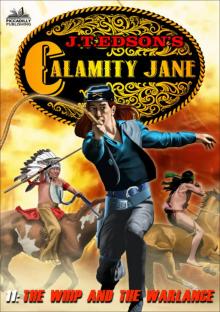 Calamity Jane 11
Calamity Jane 11 The Floating Outift 33
The Floating Outift 33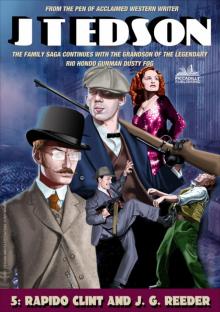 Cap Fog 5
Cap Fog 5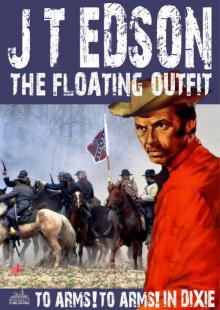 The Floating Outfit 34
The Floating Outfit 34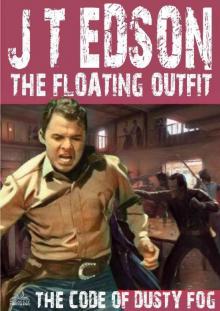 The Code of Dusty Fog
The Code of Dusty Fog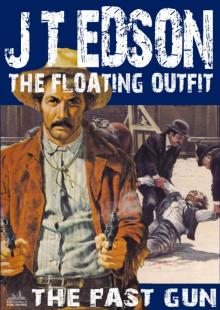 The Floating Outfit 21
The Floating Outfit 21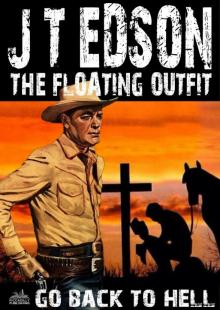 The Floating Outift 36
The Floating Outift 36 Calamity Jane 2
Calamity Jane 2 Calamity Jane 6: The Hide and Horn Saloon (A Calamity Jane Western)
Calamity Jane 6: The Hide and Horn Saloon (A Calamity Jane Western) Waco 7
Waco 7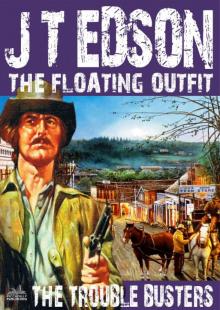 The Floating Outfit 25
The Floating Outfit 25 Waco 7: Hound Dog Man (A Waco Western)
Waco 7: Hound Dog Man (A Waco Western) The Floating Outfit 47
The Floating Outfit 47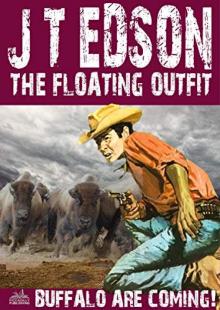 The Floating Outfit 42: Buffalo Are Coming!
The Floating Outfit 42: Buffalo Are Coming!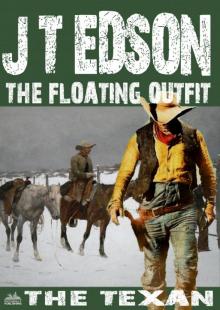 The Floating Outfit 46
The Floating Outfit 46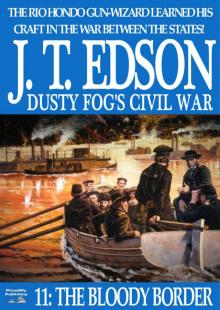 Dusty Fog's Civil War 11
Dusty Fog's Civil War 11 The Floating Outfit 61
The Floating Outfit 61 The Owlhoot
The Owlhoot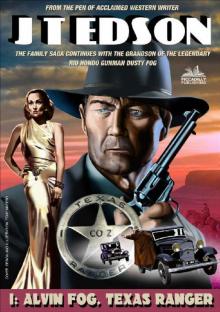 Alvin Fog, Texas Ranger
Alvin Fog, Texas Ranger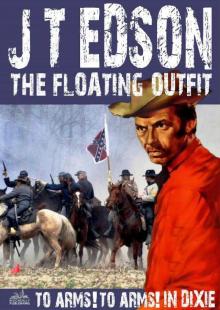 The Floating Outfit 34: To Arms! To Arms! In Dixie! (A Floating Outfit Western)
The Floating Outfit 34: To Arms! To Arms! In Dixie! (A Floating Outfit Western)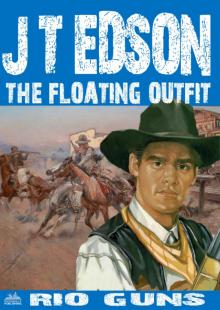 The Floating Outfit 44
The Floating Outfit 44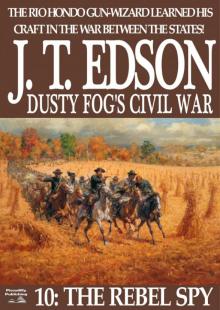 Dusty Fog's Civil War 10
Dusty Fog's Civil War 10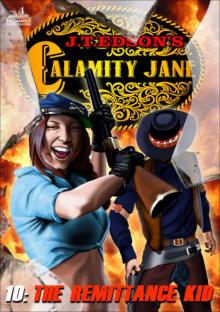 Calamity Jane 10
Calamity Jane 10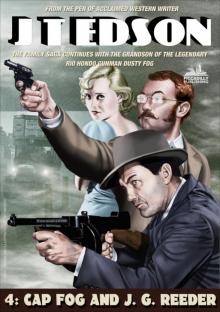 Cap Fog 4
Cap Fog 4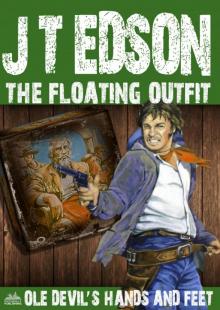 The Floating Outfit 51
The Floating Outfit 51 The Floating Outfit 50
The Floating Outfit 50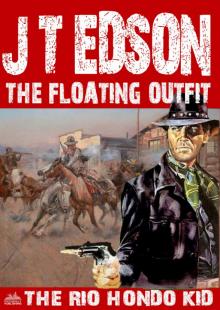 The Floating Outfit 49
The Floating Outfit 49 The Floating Outfit 10
The Floating Outfit 10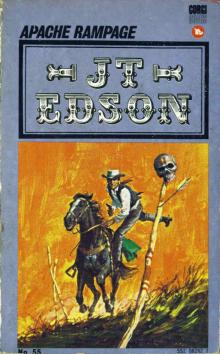 Apache Rampage
Apache Rampage The Floating Outfit 15
The Floating Outfit 15 Ranch War
Ranch War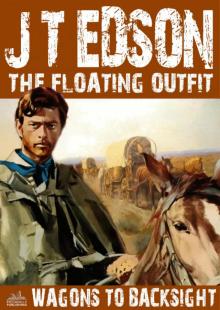 The Floating Outfit 11
The Floating Outfit 11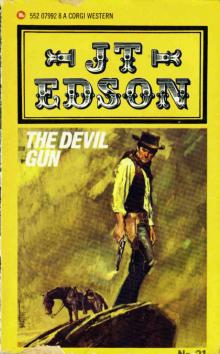 The Devil Gun
The Devil Gun Sacrifice for the Quagga God (A Bunduki Jungle Adventure Book 3)
Sacrifice for the Quagga God (A Bunduki Jungle Adventure Book 3)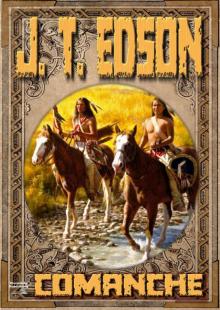 Comanche (A J.T. Edson Western Book 1)
Comanche (A J.T. Edson Western Book 1) The Floating Outfit 48
The Floating Outfit 48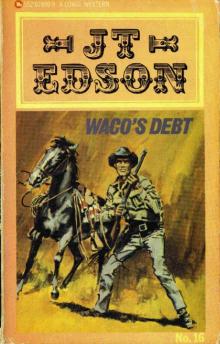 Wacos Debt
Wacos Debt The Rebel Spy
The Rebel Spy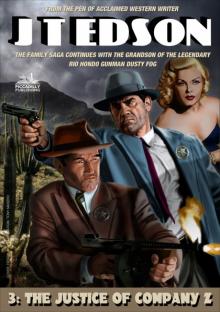 Cap Fog 3
Cap Fog 3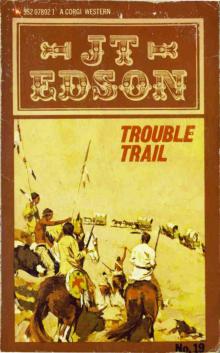 Trouble Trail
Trouble Trail Cold Deck, Hot Lead
Cold Deck, Hot Lead Rockabye County 4
Rockabye County 4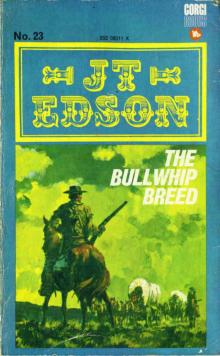 The Bullwhip Breed
The Bullwhip Breed Set Texas Back On Her Feet (A Floating Outfit Western Book 6)
Set Texas Back On Her Feet (A Floating Outfit Western Book 6)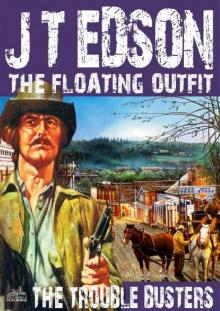 The Floating Outfit 25: The Trouble Busters (A Floating Outfit Western)
The Floating Outfit 25: The Trouble Busters (A Floating Outfit Western) Fearless Master of the Jungle (A Bunduki Jungle Adventure
Fearless Master of the Jungle (A Bunduki Jungle Adventure Wanted! Belle Starr!
Wanted! Belle Starr! The Big Hunt
The Big Hunt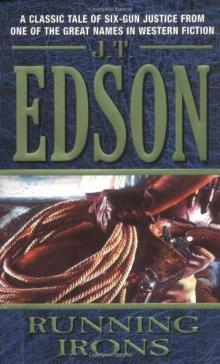 Running Irons
Running Irons The Floating Outfit 19
The Floating Outfit 19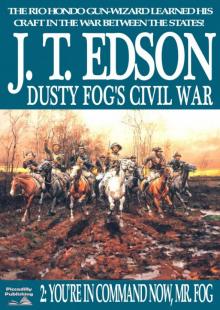 You're in Command Now, Mr Fog
You're in Command Now, Mr Fog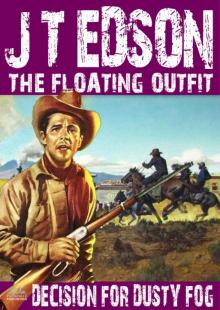 The Floating Outfit 27
The Floating Outfit 27 Texas Killers
Texas Killers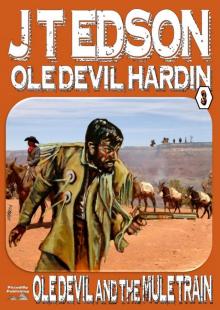 Ole Devil and the Mule Train (An Ole Devil Western Book 3)
Ole Devil and the Mule Train (An Ole Devil Western Book 3) Bunduki and Dawn (A Bunduki Jungle Adventure Book 2)
Bunduki and Dawn (A Bunduki Jungle Adventure Book 2)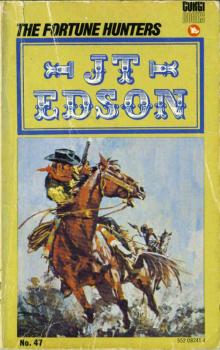 The Fortune Hunters
The Fortune Hunters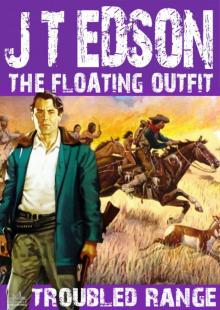 The Floating Outfit 12
The Floating Outfit 12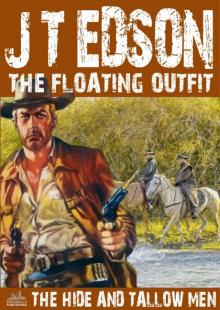 The Hide and Tallow Men (A Floating Outfit Western. Book 7)
The Hide and Tallow Men (A Floating Outfit Western. Book 7)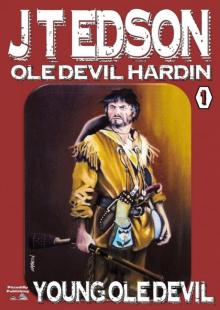 Young Ole Devil
Young Ole Devil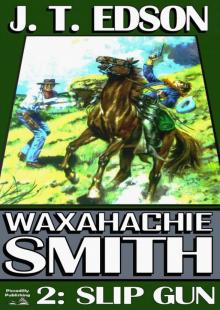 Slip Gun
Slip Gun The Drifter
The Drifter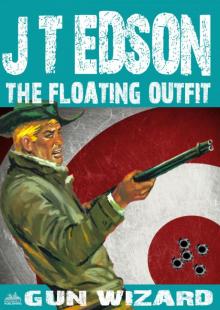 The Floating Outfit 45
The Floating Outfit 45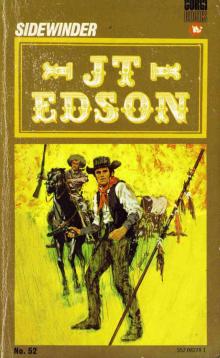 Sidewinder
Sidewinder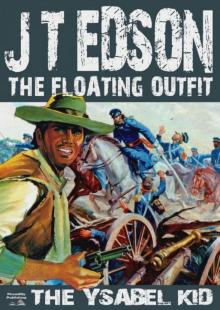 The Ysabel Kid
The Ysabel Kid Waco 6
Waco 6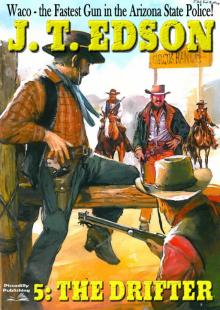 Waco 5
Waco 5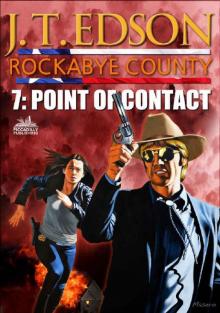 Point of Contact
Point of Contact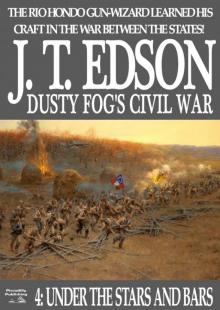 Under the Stars and Bars (A Dusty Fog Civil War Western Book 4)
Under the Stars and Bars (A Dusty Fog Civil War Western Book 4)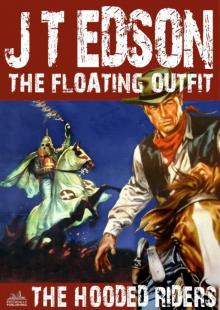 The Floating Outfit 9
The Floating Outfit 9 Under the Stars and Bars
Under the Stars and Bars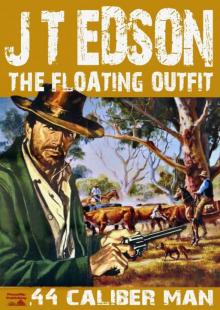 .44 Caliber Man
.44 Caliber Man The Floating Outfit 17
The Floating Outfit 17 Ole Devil at San Jacinto (Old Devil Hardin Western Book 4)
Ole Devil at San Jacinto (Old Devil Hardin Western Book 4)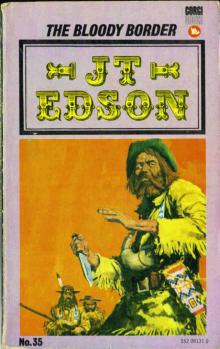 The Bloody Border
The Bloody Border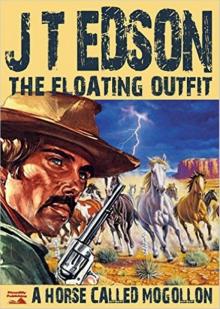 A Horse Called Mogollon (Floating Outfit Book 3)
A Horse Called Mogollon (Floating Outfit Book 3)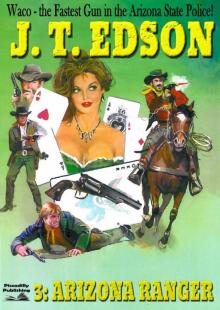 Waco 3
Waco 3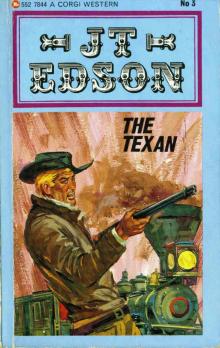 The Texan
The Texan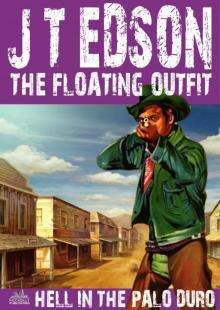 The Floating Outfit 35
The Floating Outfit 35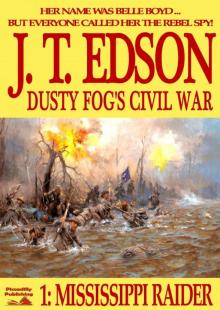 Mississippi Raider
Mississippi Raider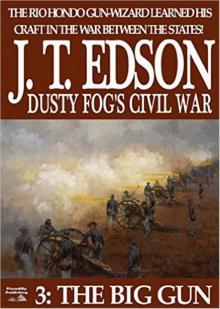 The Big Gun (Dusty Fog's Civil War Book 3)
The Big Gun (Dusty Fog's Civil War Book 3)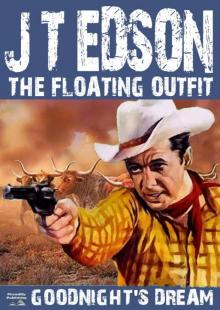 Goodnight's Dream (A Floating Outfit Western Book 4)
Goodnight's Dream (A Floating Outfit Western Book 4) Waco 4
Waco 4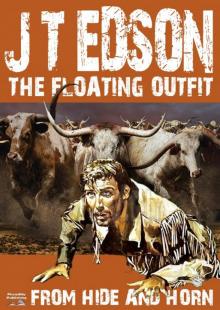 From Hide and Horn (A Floating Outfit Book Number 5)
From Hide and Horn (A Floating Outfit Book Number 5) The Floating Outfit 18
The Floating Outfit 18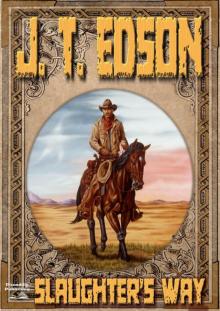 Slaughter's Way (A J.T. Edson Western)
Slaughter's Way (A J.T. Edson Western)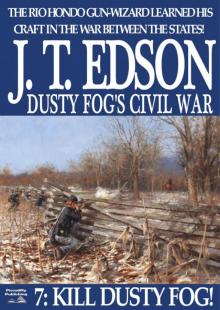 Dusty Fog's Civil War 7
Dusty Fog's Civil War 7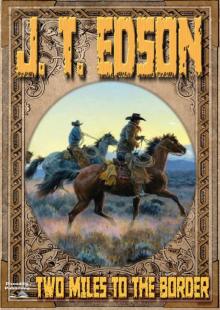 Two Miles to the Border (A J.T. Edson Western)
Two Miles to the Border (A J.T. Edson Western)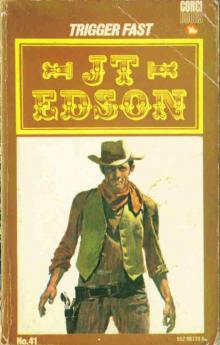 Trigger Fast
Trigger Fast Waco's Badge
Waco's Badge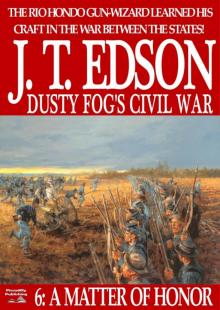 A Matter of Honor (Dusty Fog Civil War Book 6)
A Matter of Honor (Dusty Fog Civil War Book 6)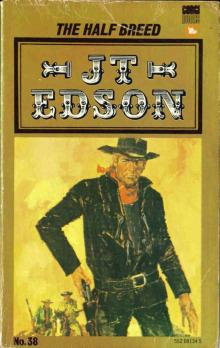 The Half Breed
The Half Breed Bunduki (Bunduki Series Book One)
Bunduki (Bunduki Series Book One) Kill Dusty Fog
Kill Dusty Fog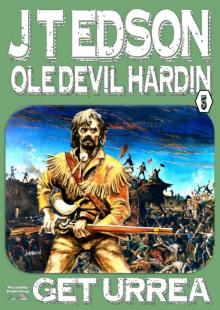 Get Urrea! (An Ole Devil Hardin Western Book 5)
Get Urrea! (An Ole Devil Hardin Western Book 5)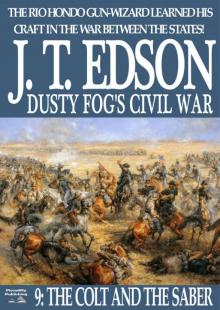 Dusty Fog's Civil War 9
Dusty Fog's Civil War 9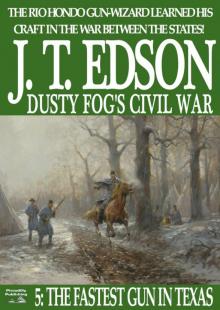 The Fastest Gun in Texas (A Dusty Fog Civil War Book 5)
The Fastest Gun in Texas (A Dusty Fog Civil War Book 5)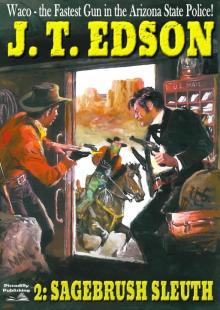 Sagebrush Sleuth (A Waco Western #2)
Sagebrush Sleuth (A Waco Western #2)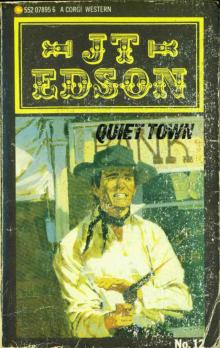 Quiet Town
Quiet Town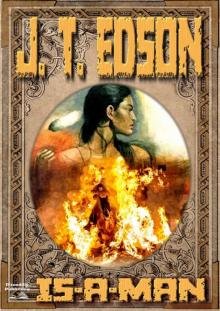 Is-A-Man (A J.T. Edson Standalone Western)
Is-A-Man (A J.T. Edson Standalone Western) Rockabye County 5
Rockabye County 5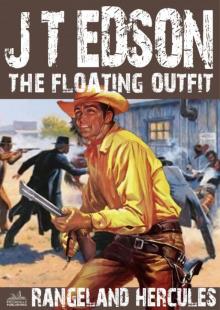 The Floating Outfit 14
The Floating Outfit 14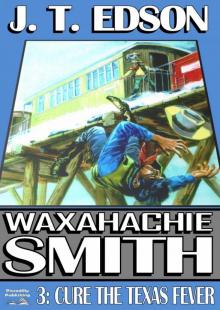 Cure the Texas Fever (A Waxahachie Smith Western--Book 3)
Cure the Texas Fever (A Waxahachie Smith Western--Book 3)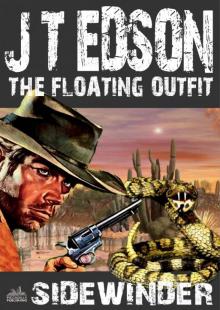 The Floating Outfit 13
The Floating Outfit 13 The Road to Ratchet Creek
The Road to Ratchet Creek